In the past 2016, in the computer industry, I believe that no concept is more popular than artificial intelligence. Entering 2017, experts say that the demand for artificial intelligence ecosystems will grow even more rapidly. Mainly focused on finding the "engine" that is more suitable for deep neural networks for performance and efficiency.
Today's deep learning systems rely on software-defined networks and the sheer computing power of big data learning to achieve their goals. Unfortunately, this type of computing configuration is difficult to embed in systems where computing power, storage size, and bandwidth are limited (such as cars, drones, and IoT devices).
This presents a new challenge for the industry, how to embed the computing power of deep neural networks into terminal devices through innovation.
Movidius CEO Remi El-Ouazzane said a few months ago that placing artificial intelligence on the edge of the network would be a big trend.

Remi El-Ouazzane
When asked why artificial intelligence was “rushed†to the edge of the network, CEA Architecture Fellow Marc Duranton gave three reasons: security, privacy, and economy. He believes that these three points are important factors driving the industry to process data at the terminal. He pointed out that in the future, there will be more demand for “transforming data into informationâ€. And the sooner these data are processed, the better, he added.
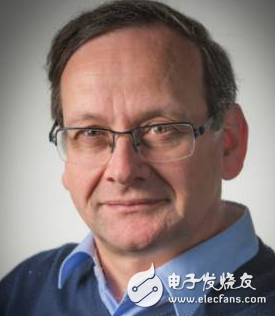
CEA Architecture Fellow Marc Duranton
Camera, if your driverless car is safe, then these unmanned functions do not need to rely on the alliance for a long time; if the old man falls at home, then this situation should be detected and judged on the spot. These are very important for privacy reasons, Duranton stressed.
But this does not mean that all the pictures of the ten cameras in the home are collected and sent to me, which is called a reminder of a number. This does not reduce "energy, cost and data size," Duranton added.
The competition officially opened
From the current situation, chip suppliers have realized the growing demand for inference engines. Many semiconductor companies, including Movidus (Myriad 2), Mobileye (EyeQ 4 & 5) and Nvidia (Drive PX), are competing for low-power, high-performance hardware accelerators. Help developers better perform "learning" in embedded systems.
From the perspective of the actions of these vendors and the development direction of SoC, in the post-smartphone era, the inference engine has gradually become the next target market pursued by semiconductor manufacturers.
Earlier this year, Google's TPU turned out to be an indication of the industry's intention to drive innovation in machine learning chips. When the chip was released, the search giant said that the performance per watt of TPU would be an order of magnitude higher than that of traditional FPGAs and GPUs. Google also said that the accelerator has also been applied to the AlphaGo system, which was popular around the world earlier this year.
But since its release, Google has never disclosed the specifics of TPU, let alone sell it.
Many SoC practitioners have come to the conclusion from Google's TPU that they believe that machine learning requires a customized architecture. But when they do chip design for machine learning, they are doubtful and curious about the architecture of the chip. At the same time, they want to know if the industry already has a tool to measure the performance of deep neural networks (DNN) in different forms.
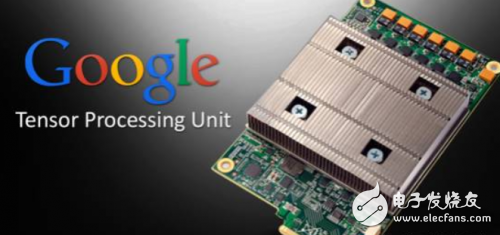
Tools have arrived
CEA claims that they have prepared for the inference engine to explore different hardware architectures, and they have developed a software architecture called N2D2. They are enough to help designers explore and claim the DNN architecture. "We developed this tool to help DNN choose the right hardware," Duranton said. By the first quarter of 2017, this N2D2 will be open source. Duranton promised.
N2D2 is characterized by not only comparing hardware based on recognition accuracy, but also comparing it in terms of processing time, hardware cost and energy loss. Because the hardware configuration parameters required for different deep learning applications are different, so the above points are the most important, Duranton said.
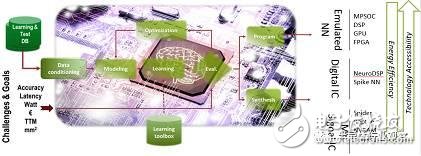
How N2D2 works
N2D2 provides a reference standard for existing CPUs, GPUs, and FPGAs.
Barriers to edge computing
As a senior research organization, CEA has conducted in-depth research on how to extend DNN to the field of edge computing. When asked about the obstacles to this kind of advancement, Duranton pointed out that these "floating point" server solutions cannot be applied due to power consumption, size and latency limitations. This is the biggest obstacle. Other obstacles include "a large number of Macs, bandwidth and size on the chip," Duranton added.
That is to say how to integrate this "floating point" method is the first problem that should be solved.
Duranton believes that some new architectures are inevitable, and some new coding like "spike code" is inevitable.
According to CEA research, even binary encoding is not required. They believe that time coding like spike coding can emit more powerful energy at the edge.
Spike coding is popular because it clearly demonstrates the decoding of data within the nervous system. In the deepest sense, these event-based encodings are compatible with dedicated sensors and pre-processing.
This extremely similar encoding to the nervous system makes hybrid analog and digital signals easier to implement, which also helps researchers create low-power hardware accelerators.
CEA is also thinking about the potential to adjust the neural network architecture to edge computing. Duranton pointed out that people are now pushing to use 'SqueezeNet to replace AlexNet. According to reports, in order to achieve the same accuracy, the former uses 50 times less parameters than the latter. This type of simple configuration is important for edge computing, topology, and reducing the number of Macs.
Duranton believes that moving from a classic DNN to an embedded network is a spontaneous act.
P-Neuro, a temporary chip
CEA's ambition is to develop a neuromorphic circuit. Researchers believe that such a chip is an effective complement to push data extraction on the sensor side in deep learning.
But before reaching this goal, CEA got along with a lot of expediency. For example, the development of tools such as D2N2 helps chip developers develop high-TOPS DNN solutions.
For those who want to transfer DNN to edge computing, they also have the corresponding hardware to implement. This is the low-power programmable accelerator from CEA, P-Neuro. The current P-Neuro chip is based on FPGA development. But Duranton said they have turned this FPAG into an ASIC.
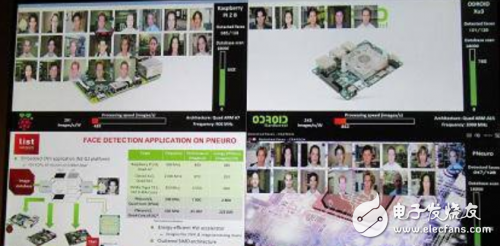
P-Neuro demo compared to embedded CPU
In CEA's lab, Duranton has built a facial recognition convolutional neural network (CNN) in this FPAG-based P-Neuro. This P-Neuro-based demo is compared to the embedded CPU. (Raspberry pie, Android device with Samsung Exynos processor). They also all run the same CNN application. They all arranged to perform "face feature extraction" from a database of 18,000 images.
According to the example, the speed of P-Neuro is 6,942 images per second, while the power consumption is only 2,776 images per watt.
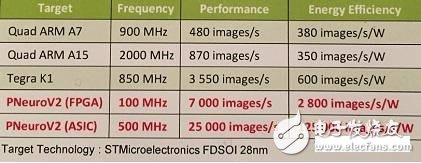
P-Neuro and GPU, CPU comparison
As shown, the FPGA-based P-Neuro works faster and consumes less power at 100Mhz operating frequency than the Tegra K1.
P-Neuro is built on a cluster-based SIMD architecture that is well known for its optimized hierarchical memory architecture and internal connectivity.
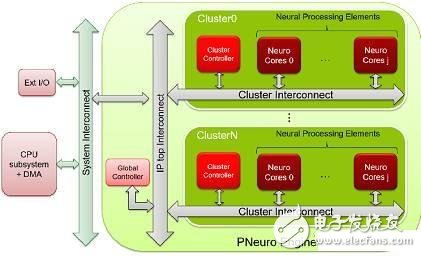
Block diagram of P-Neuro
For CEA researchers, P-Neuro is only a short-term solution. The current P-Neuro is built on a CMOS device using binary encoding. Their team is building a full CMOS solution and is planning to use spike coding.
In order to take full advantage of the advantages of advanced equipment and break the issue of density and power, their team set a higher goal. They considered RRAM as a synapse element and considered processes such as FDSOI and nanowires.
In a "EU Horizon 2020" program, they hope to make a neuromorphic architecture chip that can support the most advanced machine learning. It is also a spike-based learning mechanism.
Neuromorphic processor
This is a project called NeuRAM3. By then, their chips will have ultra-low power, size and highly configurable neural architecture. Their goal is to create a product that can reduce power consumption by a factor of 50 compared to traditional solutions.
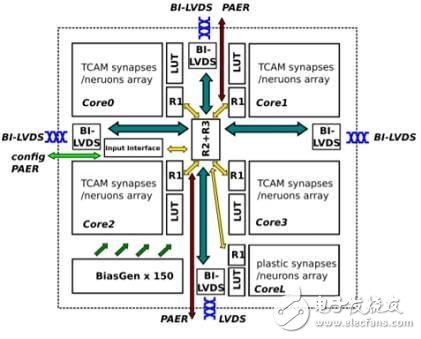
Neuromorphic processor
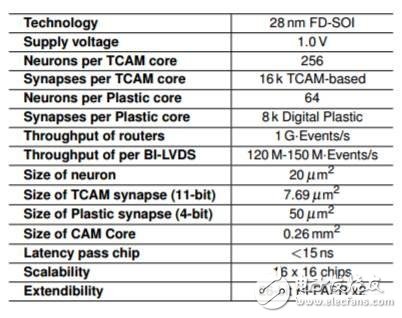
Basic parameters of the Neuromorphic processor
According to reports, this solution includes the integrated 3D technology based on the FD-SOI process, and also uses RRAM to make synaptic elements. Under the NeuRAM3 project, this new mixed-signal multi-core neuromorphic chip device can significantly reduce power consumption compared to IBM's TrueNorth.
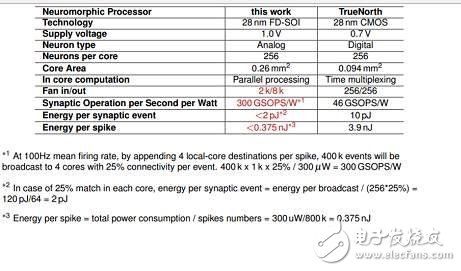
Contrast with IBM's TrueNorth
Participants in the NeuRAM3 project include IMEC, IBM Zurich, ST Microelectronics, CNR (The NaTIonal Research Council in Italy), IMSE (El InsTItuto de Microelectrónica de Sevilla in Spain), the University of Zurich and the University of Jacobs in Germany.
More AI chip competition
In fact, the AI ​​chip market has attracted a lot of players, both traditional semiconductor manufacturers and so-called start-ups, have begun to go to this next gold mine. In addition to the CEA mentioned above. Let's take a look at what other AI chips are on the market.
First, the follow-up of traditional manufacturers
(1) Nvidia
NVIDIA is the GPU overlord. Although they missed the mobile era, they seem to have regained their glory in the AI ​​era. From the stock trend in the past year, they can see the confidence of the market. Let's see what plans he has in this area.
In April of this year, Nvidia released an advanced machine learning chip, the Tesla P100 GPU. According to Nvidia CEO Huang Renxun, this product has 12 times faster processing speed than NVIDIA's predecessor. The $2 billion developed chip integrates 150 billion transistors.
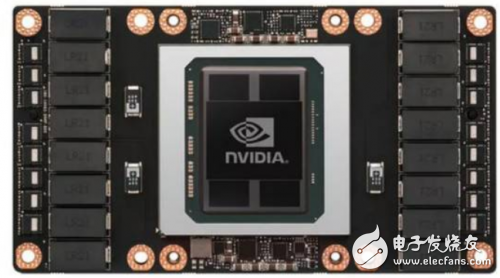
According to the introduction, the new NVIDIA Pascal? The architecture enables the Tesla P100 to deliver exceptional performance for HPC and very large workloads. With more than 20 trillion FP16 floating-point performance per second, the optimized Pascal brings exciting new possibilities for deep learning applications.
By adding CoWoS (wafer-based chip) technology using HBM2, the Tesla P100 tightly integrates computing and data in the same package with more than three times the memory performance of previous generation solutions. This allows the problem-solving time of data-intensive applications to leapfrog across the ages.
Furthermore, because of the NVIDIA NVLink? Technology, the fast nodes of the Tesla P100 can significantly reduce the time it takes to provide solutions for applications with strong scalability. Server nodes with NVLink technology can interconnect up to eight Tesla P100s with 5x PCIe bandwidth. This design is designed to help solve the globally significant challenges of HPC and deep learning with significant computing needs.
(2) Intel
In November of this year. Intel has released an AI processor called Nervana, which they claim will test the prototype in the middle of next year. If all goes well, the final form of the Nervana chip will be available in 2017. The chip is based on a company called Nervana that Intel bought earlier. According to Intel, the company is the first company on the planet to build chips for AI.
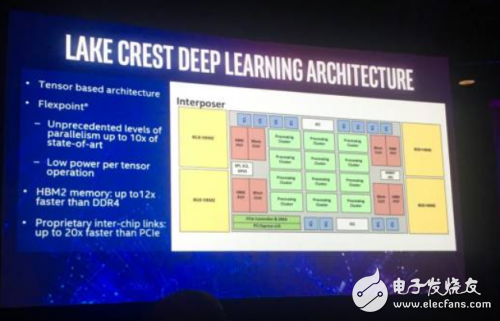
Intel disclosed some details about the chip. According to them, the project code is "Lake Crest" and will use Nervana Engine and Neon DNN related software. . The chip accelerates a variety of neural networks, such as the Google TensorFlow framework. The chip consists of a so-called "processing cluster" array that handles simplified mathematical operations called "active points." This method requires less data than floating-point operations, resulting in a 10x performance boost.
Lake Crest uses private data connections to create larger, faster clusters with a circular or other topology. This helps users create larger, more diverse neural network models. This data connection contains 12 100Gbps bidirectional connections, and its physical layer is based on 28G serial-to-parallel conversion.
The 2.5D chip is equipped with 32GB of HBM2 memory and has a memory bandwidth of 8Tbps. There is no cache in the chip, and the software is used to manage on-chip storage.
Intel did not disclose the future roadmap for this product, only that it plans to release a version called Knights Crest. This version will integrate future Xeon processors and Nervana acceleration processors. This is expected to support the Nervana cluster. However, Intel did not disclose how and when these two types of chips will be integrated.
As for the integrated version, there will be more performance and easier programming. Current graphics processing chip (GPU)-based accelerated processors make programming more complicated because developers maintain separate GPU and CPU memory.
According to reports, by 2020, Intel will launch chips to improve the performance of neural network training by 100 times. One analyst said the goal was "extremely radical." There is no doubt that Intel will quickly move this architecture to more advanced manufacturing processes, competing with GPUs that already use 14nm or 16nm FinFET processes.
(3) IBM
Centennial giant IBM, who published wtson a long time ago, has now invested in a lot of research and development. In the past year, he also couldn't help but invest in the research and development of human brain chips. That is TrueNorth.
TrueNorth is the latest achievement of IBM's participation in DARPA's research project, SyNapse. SyNapse's full name is Systems of Neuromorphic AdapTIve PlasTIc Scalable Electronics, and SyNapse is synaptic. The ultimate goal is to develop a broken von? The hardware of the Neumann system.
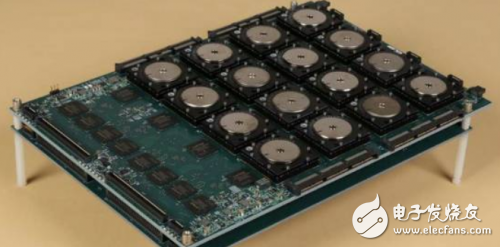
This chip treats the digital processor as a neuron and uses memory as a synapse. Unlike traditional von Neumann architecture, its memory, CPU and communication components are fully integrated. Therefore, the processing of information is completely local, and since the amount of data processed locally is not large, the bottleneck between the traditional computer memory and the CPU no longer exists. At the same time, neurons can communicate with each other conveniently and quickly. As long as they receive pulses (action potentials) from other neurons, these neurons will act simultaneously.
In 2011, IBM first introduced a single-core chip prototype with 256 neurons, 256 × 256 synapses and 256 axons. The prototype at the time was already able to handle complex tasks like playing Pong games. However, it is relatively simple. In terms of scale, such a single-core brain capacity is only equivalent to the level of the brain.
However, after three years of hard work, IBM finally made a breakthrough in complexity and usability. 4096 cores, 1 million "neurons", 256 million "synapses" are integrated between a few centimeters in diameter (1/16 of the prototype size in 2011), and consume less than 70 Milliwatts, IBM's integration is really impressive.
What can such a chip do? The IBM research team has used the NeoVision2 Tower dataset that has been done with DARPA for demonstrations. It can identify people, bicycles, buses, trucks, etc. in the crossroads video of Stanford University's Hoover Tower at a normal speed of 30 frames per second, with an accuracy rate of 80%. In contrast, a notebook programming is 100 times slower to complete the same task, and the energy consumption is 10,000 times that of the IBM chip.
As with traditional computers using FLOPS (floating operations per second) to measure computing power, IBM uses SOP (synaptic operations per second) to measure the power and energy efficiency of such computers. The energy required to complete the 46 billion SOP is only 1 watt—as described at the beginning of the article, this capability is a supercomputer, but a small hearing aid battery can be driven.
The communication efficiency is extremely high, which greatly reduces energy consumption. This is the biggest selling point of this chip. Each core of TrueNorth has 256 neurons, each of which is connected to 256 neurons inside and outside.
(4) Google
In fact, on Google, I am very entangled, whether this is a new force, or a traditional company. But considering Google has been for so many years, I will put him in the tradition. Although the tradition is also very new. And Google's artificial intelligence related chip is the TPU. That is the Tensor Processing Unit.
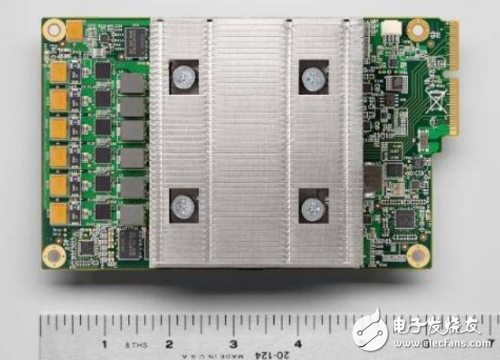
The TPU is a dedicated chip designed specifically for machine learning applications. By reducing the computational accuracy of the chip and reducing the number of transistors required to implement each computational operation, the number of operations per second of the chip can be increased, so that a fine-tuned machine learning model can be run on the chip. Faster, and thus faster, for users to get smarter results. Google embeds the TPU accelerator chip into the board and uses the existing hard disk PCI-E interface to access the data center server.
According to Urs Holzle, senior vice president of Google, the current use of Google TPU and GPU will continue for a while, but it is also said that the GPU is too general and Google prefers chips designed for machine learning. The GPU can perform drawing operations and has many uses. The TPU is an ASIC, which is a special specification logic IC designed for specific purposes. Because it only performs a single job, it is faster, but the disadvantage is higher cost. As for the CPU, Holzle said that the TPU will not replace the CPU, and the TPU is only developed to deal with unresolved issues. But he also pointed out that he hopes that the chip market will have more competition.
If the AI ​​algorithm changes (logically the algorithm should change over time), do you want a chip that can be reprogrammed to accommodate these changes? If this is the case, another chip is suitable, it is the FPGA (Field Programmable Gate Array). FPGAs can be programmed to be different from ASICs. Microsoft uses some FPGA chips to enhance the AI ​​capabilities of Bing search engines. We naturally ask: Why not use an FPGA?
Battery holders are key components in many types of portable and anchored electrical items - and you`ll find just as many varieties, brands, sizes and types of battery holder available across global markets as there are different sorts of battery.
In this guide, we`ll look more closely at some of the various mounting styles a battery holder might come fitted with, as well as the many different cell sizes they`re designed to work with.
What is a battery holder?
Battery Holders & Mounts
A battery holder is most commonly sold as an integral or removable compartment or cavity, designed to be inserted into - or attached onto - a suitable item of cell-powered equipment.
The primary function of a battery holder is to keep cells fixed in place safely and securely while conveying power from the batteries to the device in question. External connections on battery holders are most often made by contacts either with pins, surface mount feet, soldered lugs or via a set of wire leads.
Battery holders are often designed to be incorporated within the body of an electrical item, but they`re also frequently sold as external compartments or attachments. Either way, some of the most important factors to consider when choosing an appropriate battery holder for a given application will be:
Battery size
Compatible cell types
Contact/terminal style
Battery mounting and insertion method
Unit size and shape
Battery holder cover and housing design
Build quality and manufacturer reputation
Holders and mounts for different battery sizes
Many different battery holder sizes and mounting types are available from manufacturers and suppliers all over the world. Most will be made to work with a particular sort of cell - or sometimes with a range of multiple battery sizes - and to be affixed to the electrical item in question in a specific way.
Bear in mind that, in addition to sorting through the wide variety of battery holder sizes and capacities on the market, you`ll also need to be mindful of the many options available in terms of actual battery chemistry.
While the vast majority of holders and mounts will be able to accommodate most battery chemistry types, each will have its own unique set of pros and cons in terms of performance, power drain, longevity, cost and environmental impact.
Common battery types sold by many suppliers might include:
Alkaline batteries
Lithium batteries
Rechargeable batteries (including li-ion)
Nickel cadmium batteries
Nickel metal hydride batteries
NiZN batteries
The above range of cell types is often available across a broad range of popular battery sizes and shapes, including both AA and AAA versions. Most, but not all, will be interchangeable in a wide range of devices, holders and mounts. However, it`s seldom advisable to combine mixed battery chemistries in a single electronic device.
Doing so can often impede device performance, as the item drawing power will only ever perform to the capabilities of the weakest battery in the holder. Of even greater concern is the fact that more powerful batteries can sometimes force weaker ones to work harder than they`re intended to, causing them to drain to very low voltage levels and possibly leading to potential leaking or rupture.
As such, it`s always wise to ensure you know which cell types you`re likely to be using in advance of making a purchase, as well as the correct sizing you`ll require.
AA Battery Holders & Mounts
An AA size battery holder is one of the more common types of battery storage compartments you`ll see on sale from UK suppliers. AA size (`double-A`), is what most people would typically think of as a `standard` battery, and remains extremely common in all kinds of portable electrical items and equipment.
AA battery pack holders can be manufactured to house any number of cells in theory, but in daily use it`s usually anywhere between 1-10 batteries, with 2-8 being by far the most popular options. AA single battery holders are also common.
Relatively few cell-powered tools or other pieces of electrical equipment will be designed to require more than 8 AA batteries for achieving sufficient power supply. Items that demand a higher power draw than this will usually be built around a larger cell type, for improved practicality and less frequent need for battery replacement or recharging.
AAA Battery Holders and Mounts
Battery holders for AAA cells, commonly referred to as `triple-A` are another very common configuration. AAA batteries are smaller and slimmer than AA versions, with around a third of the storage capacity.
Due to the increasing efficiency of many device types, AAA batteries are often found in more compact pieces of equipment that would typically have been expected to run off double-A cells in years gone by. Today, these will very often include low-drain portable or handheld electronic goods or tools, such as:
Remote controls
Mp3 players, handheld gaming systems and other portable entertainment devices
Digital cameras
Cordless mice or keyboards
Flashlights and other portable lighting units
Clocks and alarms
Kitchen gadgets
AAA battery holders are generally built to accommodate fewer individual cells than bigger units for housing AA and larger capacity batteries, as devices requiring more power will typically not run off triple-A cells.
An AAAA battery holder is a somewhat less common configuration, given that the much smaller than average AAAA (`quadruple-A` or `four-A`) cell standard drains considerably faster than AA or AAA equivalents.
C Battery Holders and Mounts
C size battery holders are designed around the fairly common C battery (sometimes known as an R14). This is a fairly wide diameter cylindrical cell, smaller than D batteries while being the same height - but significantly wider - than AA standard.
C cell batteries, holders and mounts are less widely used than either AA or D versions, particularly since power efficiency is continually improving across most cell-powered devices. However, they can still often be found on a range of medium-drain electronic items, including:
Heavier flashlights and smaller ambient lighting fixtures (e.g. table lamps)
Radios and portable speakers
Toys and games Musical instruments and amplifiers
D Battery Holders and Mounts
D batteries are among the larger types of `everyday use` cells you`ll commonly encounter around the home or workplace. D size batteries tend to be used for higher-drain devices that tend to be used for longer periods at a time, including:
High Power torches and flashlights
Safety systems
Geiger counters
Megaphones, larger musical instruments and more powerful audio devices or speakers
Motorised toys and portable gaming consoles
Products with inbuilt electric motors
Battery holders for D cells are most commonly sold in configurations designed to house either 2 or 4 individual batteries.
12V Battery Holders and Mounts
Battery holders for 12V cells are somewhat less widely available, chiefly because the 12V standard incorporates such a wide range of battery shapes and sizes, although 12V Battery Contacts themselves are more commonly sold as separate components (see Battery holder mounts, below).
The precise sort of 12V battery you might need for specific applications will dictate the appropriate form factor, which can be anything from a large heavy car battery type to one closely resembling a traditional AA cell.
With larger 12V batteries, in particular, it`s less common to need more than one at a time, and they`re generally built more intrinsically into the device or equipment being powered than other types of `snap in/out` batteries designed for frequent and quick replacement. This means that 12V battery holders and mounts aren`t as frequently sold by many UK suppliers as versions for other, more common cell types.
Battery holder mounts
Battery holder mounts usually refer to the way the battery holder itself is slotted, secured or attached onto or into the main body of the item being powered. Note, however, that the term `battery mount` is also used to refer to the method by which individual cells are held in place within the overall holder unit.
Battery holder mounts and battery mounts are usually present as an integral part of a complete holder unit, but you can also buy battery mounts cheaply as swap-out or replacement parts. They can come in many different configurations and designs, with some of the more common types being:
Chassis mount
Panel mount
PCB mount
Slide-in mount (usually refers to the battery insertion method)
Snap-in mount (usually refers to the battery insertion method)
Strap & lead mount (a battery connector, rather than a holder per se)
Surface mount
Through-hole mount
Wire lead mount (refers to connection type)
In this section, we`ll look at some of the most widely used battery mount types in everyday use
Chassis Mount Battery Holders
A chassis mount battery holder denotes one intended to be affixed to a surface plate within the main body of the device being powered, and will usually remain in place while batteries are being swapped. A chassis mount holder is usually attached either via fixing holes in the back of the casing - i.e. a through-hole mount - or via tabs located around the sides of the battery holder.
Chassis mount battery holders can be either metal or plastic, open faced or enclosed (i.e. with or without a cover), and are commonly designed to accept a wide range of cell sizes including AA, AAA, C, D and 9V PP3
Panel Mount Battery Holders
A panel mount battery holder is designed to be slotted into a pre-existing cavity in the side, top or back exterior panel of a device, and removed entirely as a single self-contained unit when it`s time to swap out the batteries. They`re often manufactured such that the cover of the battery holder will sit flush with the device`s panel once inserted
Panel mount battery holders are most commonly secured in place via one of two methods - either via a screw-in system for optimal stability or with a flange for easier removal and reinsertion.
PCB Mount Battery Holders
As the name implies, a PCB mount battery holder is intended for applications where the battery holder needs to be installed directly onto a printed circuit board
The most common design is for the PCB mount holder to include several small sharp pins around its perimeter - these are pushed directly through the surface of the PCB and then soldered on from the rear side
Holders for PCB mounted batteries can be made from metal or plastic. While they`re frequently built to accommodate single coin cells, such as you might find on a typical computer motherboard, they can also be configured to allow for multiple cells and other battery types, including cylindrical AAA, AA, C, or D cells
Slide In Mount Battery Holders
As noted above, a slide-in mount battery holder will generally refer to the way the individual cells are inserted into and removed from the battery holder as a whole.
Slide-in mounts are arguably the most common type of battery connection/terminal setup, requiring the user simply to `drop` the cells into place either lengthways or side-on, at which point they`re either held in place by opposing forces from the two terminals, or secured with a cover or cap
Slide-in battery mounts tend to be among the cheapest and most cost-effective choices to buy in the UK for quickly and simply inserting a cell into an appropriate holder. They work reliably well, and are most often seen in molded plastic or metal battery holders incorporating self-contained battery compartments.
Snap-In Mount Battery Holders
A snap-in mount battery holder (sometimes called snap-on, depending on the manufacturer or supplier) denotes a terminal/contact setup where the cell is held more securely in place.
This is usually achieved using tensioned metal clips, sometimes incorporating springs, through which the battery needs to be pushed with a small amount of force before it clicks into place ready for use. Snap-in battery mounts give the device greater protection against accidental cell power loss during movement, vibration and shock
The term `snap-in` or `snap-on` is also widely used to refer to the standard contact types used on 9V cells (see Strap and lead battery holders, below).
Strap And Lead Battery Holders
Strap and lead battery holders aren`t actually holders per se, but rather a method of directly attaching a freestanding cell to an electronic device or motor without the use of an entire housing unit.
They generally consist of a wire, which is designed to be hooked up to the circuitry of the device via tinned ends, combined with a flat plastic terminal pad that attaches to the contacts of a battery via two press studs
The strap and lead battery holder type is most often used with 9V PP3 cells, allowing the cell to be lifted clear away from the main body of the item for removal, replacement or reattachment.
Surface Mount Battery Holders
A surface mount battery holder is designed to sit flat on any internal or external panel or plate, either around or inside the device being powered, and is generally open-faced.
Holders of this type are most often seen as a mounting solution for coin-type batteries with button terminal contacts, in applications where the cell doesn`t need to be connected directly to a PCB.
Types of battery holders
Once the correct size and mount style of battery holder has been chosen for your intended application and device, it`s also important to be aware of the different physical designs available for various battery holder types. In the section below, we`ll outline some of the more common versions.
Clip battery holders
A battery holder clip is a simple, economical choice for mounting batteries securely within a holder. They tend to consist of two metal arms, arranged in a loop with a small gap at the apex, through which the cells are pushed and subsequently held in place. Clip battery holders tend to be most often associated with common cylindrical batteries such as AA and AAA, but are also sold for securing C, D and 9V PP3 cells into position.
Contact battery holders
Contact battery holders refer to the simple tension-type terminal contact plates and accessories (including coil springs, button, top spring arm and leaf spring contact types) that hold a battery in place while allowing it to deliver power to the device drawing from it.
Again, these are cheap and cost-effective components widely available as separate swap-in or replacement parts that can be used to fit a very wide range of different cell sizes and battery holder types.
Through Hole Surface Mount Battery Holders
A through-hole surface mount battery holder is a common variation on the type outlined above, except it`s affixed to the surface of the device in question via a hole in the housing rather than via tabs around the perimeter. This makes the through-hole version better suited to applications where space is at a premium.
Wire Lead Mount Battery Holders
Wire lead mount battery holders denote a particular type of external connection between the battery holder itself and the circuitry of the device being powered. A wire lead mount battery holder will be supplied with two leads attached to the holder at one end, with the other ends free to be hooked into the circuitry of the device as the holder is attached.
This can offer greater flexibility in terms of battery holder mounting locations than certain pin or foot connection types, which must make immediate contact with the circuit wherever the holder is positioned.
Battery Holders
HuiZhou Antenk Electronics Co., LTD , https://www.atkconn.com